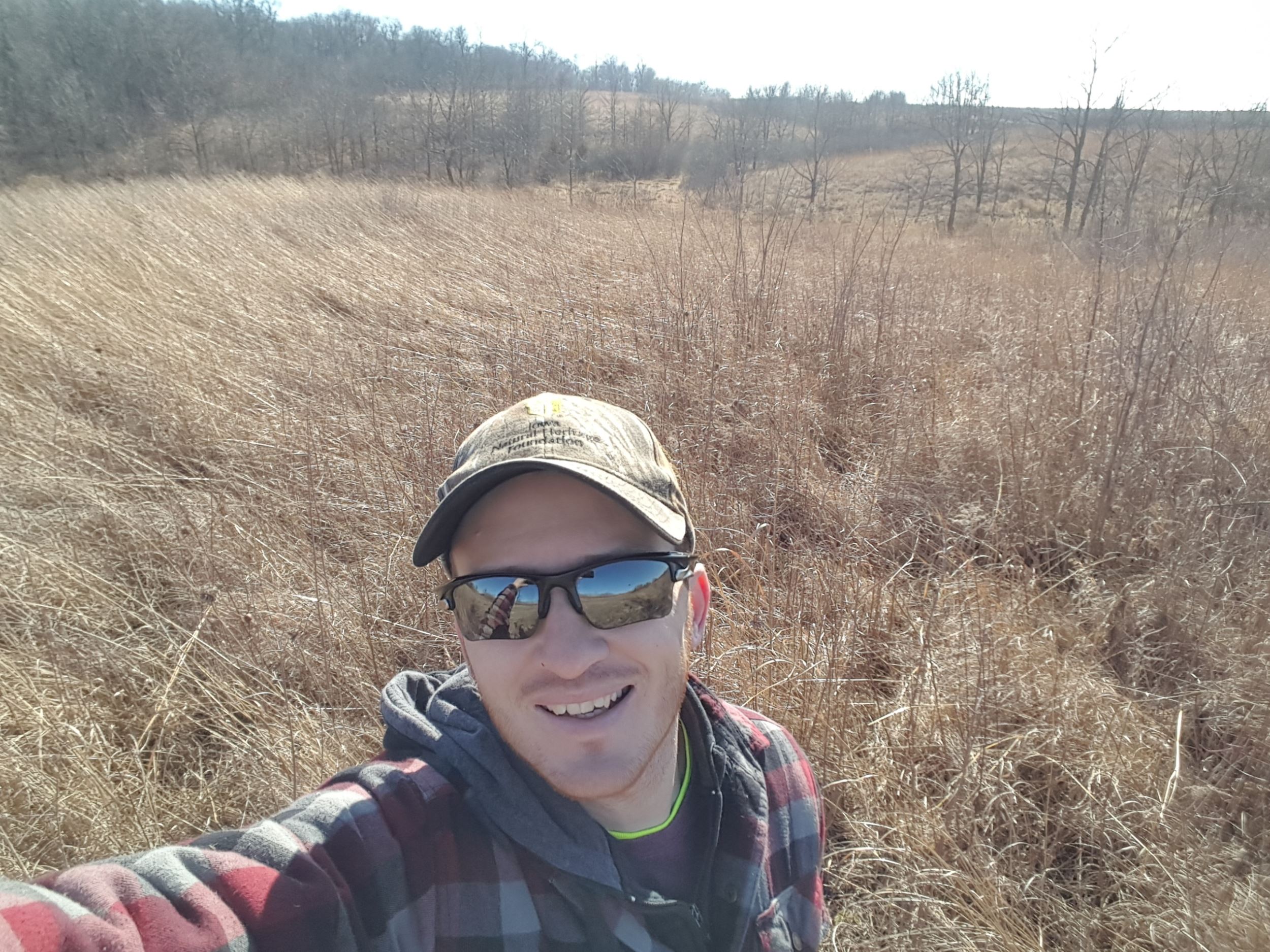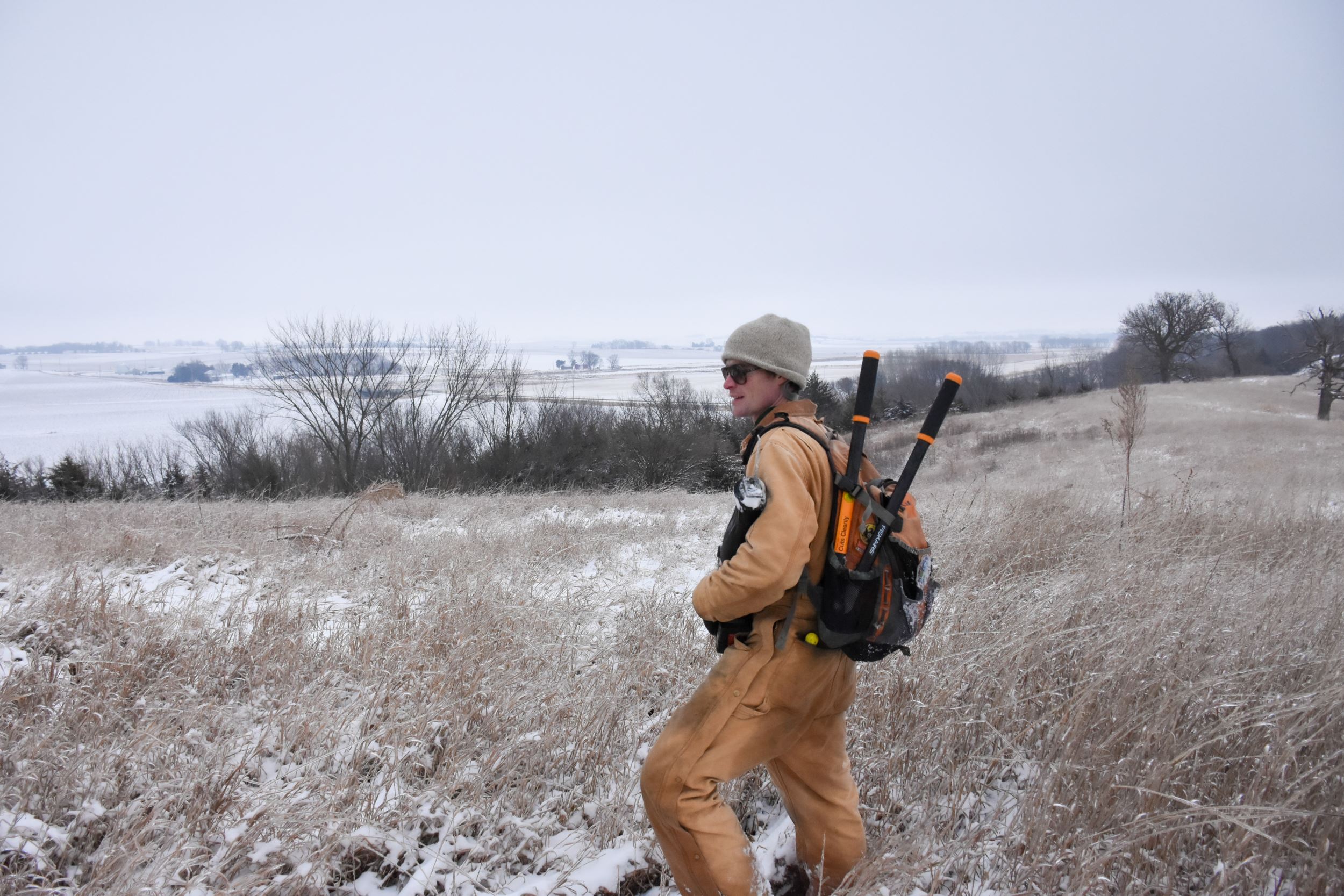Homeward Bound
By Katy Heggen on July 27, 2021 in Blog

Eastern Iowa native Tyler Baird built his career against the backdrop of the country’s most stunning national parks. But it’s not the soaring sandstone cliffs of Zion or Yosemite’s cascading waterfalls that have stayed with him over the years.
“Everywhere I went, all my favorite spots in the park were the open spaces,” Baird said. “The high, flat elevation points on the plateaus, and low, open spots in the meadows. Those were the ones I really gravitated towards. I think on some level, all along I was drawn to something that resembled Iowa’s landscape.”
Baird is one of countless young Iowans who left the state early in his conservation career. Like others, he later returned home, bringing with him a depth of knowledge and experience that is helping shape the state’s landscape.
Room to grow
Baird developed an affinity for Iowa’s outdoors during weekends spent exploring his grandparents’ cattle farm on the edge of Tipton, Iowa, where he grew up. But it wasn’t until he got to Iowa State University (ISU) and into his studies as a landscape architecture major that his interest in conservation really took off.
During his sophomore year, Baird had the opportunity to study and travel throughout the savanna region that extends from the Boundary Waters to the Rio Grande. Exploring nature on both sides of the border solidified his interest in conservation and led Baird to spend a semester on a national student exchange at the University of Idaho. While there, he applied for a summer internship with the National Park Service (NPS), a move that landed him at Zion National Park in southwest Utah and set him on course for a career with the NPS.
“I really like the public interaction aspect of it all,” Baird said. “People asking questions, excited about seeing something new and getting outdoors. I enjoyed sharing that experience with them.”
Baird’s time with the National Park Service led him to pursue a master’s degree in human dimensions of ecosystem science and management at Utah State University.
After graduation, he headed to Yosemite National Park to evaluate viewsheds, but soon felt the itch to return home. After a brief stint with the Missouri State Parks Division, he came across an opening for a horticulturist with the City of Iowa City in 2015.
“The position included managing plantings downtown and in all the city parks and natural areas – everything within the park system,” Baird said. “It covers all the different types of things I’ve done in past positions. It ended up being a good fit.”
Baird was promoted to superintendent of parks and forestry in 2020. With his new position, he plans to create areas inspired by and in symbiosis with nature in the city’s parks and public spaces.
“Iowa doesn’t have as many public spaces as some of the other places I’ve worked, but the ones we do have are well-loved by people,” Baird said. “I enjoy seeing people outside enjoying them and being part of that experience.”
Finding purpose
Like Baird, Tylar Samuels headed west shortly after graduating from the University of Iowa. Unlike Baird, it was young love, not the outdoors, that led her there.
“I was engaged at the time, and he had this desire to get out of Iowa, either temporarily or long-term,” Samuels said. “We had a friend living in Eureka, California, so away we went. It was beautiful. The ocean, the mountains, giant redwood trees.”
They had only been in California for a few months when the couple moved again, this time to the Fort Myers, Florida, to be close to her fiance´’s family. There, Samuels, who had a degree in anthropology and minor in Native American studies but had always had a passion for the outdoors, worked odd jobs for a couple of months before reaching out to the local state park to see if they were hiring. They weren’t, but referred her to an AmeriCorps crew that did contract work in southwest Florida.
“That is when I found my calling,” said Samuels. “I loved being part of something bigger and ridding the land of invasive species, doing prescribed burning and traveling around to different parks and preserves around Florida doing restoration. I was absolutely in love with it.”
The engagement didn’t last, but the newfound career calling did. After completing her service with AmeriCorps, Samuels landed a position at Estero Bay State Buffer Preserve, an 11,000+-acre preserve between Fort Myers and Naples, where she spent three years helping restore the preserve. After, she spent two years with the Lee County 2020 Program in Lee County, Florida, restoring uplands and wetlands on several preserves in and around Lee County before deciding it was time for a change.
“I just decided I wanted to be back home,” recalled Samuels, who grew up in Des Moines and St. Charles and spent many weekends exploring the city’s parks and other outdoors spaces as well as natural areas in and around Madison County with family. “But it was also really important to me to find a job in conservation.”
She began searching for a job in the natural resources field and interviewed for a position with Pottawattamie County Conservation (PCC), and while she didn’t get the job, she certainly left an impression. A PCC staff member forwarded her a position with INHF a few months later.
“I wanted the opportunity to do the type of work I was doing in Florida, but in Iowa,” Samuels said. “This is my home. I wanted to make an impact.”

Perspective & appreciation
Similar to Samuels, David Brady’s passion for conservation may have blossomed elsewhere, but was rooted in his childhood experiences in Iowa.
“I grew up running around my grandparents’ farm, catching critters and fishing, but didn’t go to national parks, hike, camp or anything like that,” said Brady, who grew up in Storm Lake, Iowa.
At ISU, this interest grew into a career path. While there, he joined the Student Conservation Association (SCA), a nonprofit that strives to “build the next generation of conservation leaders and inspire lifelong stewardship of the environment.” Through them, Brady had the opportunity to spend
a summer in the Boundary Waters, a 1,090,000-acre wilderness area in northern Minnesota popular with paddlers, hikers and anglers.
The experience inspired him to continue to explore, signing on for backpacking trips in Montana, Colorado and other spots out west. After graduating with an ecology degree, he landed a position with SCA in upstate New York doing trail maintenance and management.
From there, Brady became a self- described “wildlife vagabond,” pursuing seasonal stewardship and research positions throughout the northeast.
When his wife landed a job in Austin, Texas, Brady signed on with the state’s conservation corps, but it wasn’t long before he set off again, this time to Wyoming, where he worked with the state’s Fish & Game Department as a herpetology technician.
After several seasons going back and forth between Texas and out west, Brady joined his wife in Austin year- round and led educational, adventure- focused programs for school and public groups at the Austin Nature & Science Center.
When a family member received a serious health diagnosis two years later, the couple decided to move back to Iowa. Brady admits he was not particularly excited about his professional prospects in Iowa.
“I knew it’d be a change, that there wouldn’t be as many options as there had been out west or down south,” he said. “It was definitely bittersweet.”
Shortly after arriving, Brady landed an internship at the Neal Smith National Wildlife Refuge, a 6,000+-acre preserve in Prairie City, doing land stewardship, research and environmental education.
“Iowa has such a modified landscape. I didn’t really have a lot of exposure to Iowa’s wild lands. That experience was eye-opening,” he said.
Brady’s next move was to the classroom. Brady completed a master’s in education from Drake University and will start his first year as an environmental science teacher at North High School in Des Moines this fall.
“Thinking back to my own education, I didn’t learn about Iowa’s natural heritage,” Brady said. “There’s so little prairie and other natural lands left in Iowa. It’s important to teach people about these places that they may otherwise not have a chance to learn about or get to see. I’m excited to find ways to do that.”
Contributions and connection
Baird, Samuels, Brady and others like them offer unique contributions to Iowa’s conservation community. Their experiences working within states with different landscapes, approaches to conservation and outdoor cultures, combined with the experiences of their colleagues who have opted to focus their careers in Iowa, arguably make the field and the state’s natural resources and outdoor recreation offerings stronger.
INHF has benefited from Baird, Samuels and Brady’s decision to reestablish roots in Iowa. Seeking a way to stay connected to the land, both Baird and Brady serve as volunteer land ambassadors for INHF — Baird at Tipton Woods, 58 acres of woodland and oak savanna near Tipton, and Brady at Mathes, 51 acres of rolling hills, oak savanna and woodland near Pella.
As for Samuels, she recently celebrated her 13th anniversary with INHF. As INHF’s conservation easement specialist, she travels the state to meet with conservation easement landowners, though she still lends a hand with prescribed burns when she wants to get out on the land.
Each appreciates the home they’ve found within INHF and the larger conservation community in Iowa.
“The reason I came back was the people in Iowa,” Baird said. “Everyone works together and really enjoys the limited area we do have. We value those spaces a lot more because there aren’t as many. It really gives you a renewed sense of appreciation both for the places and the other people working to protect them.”